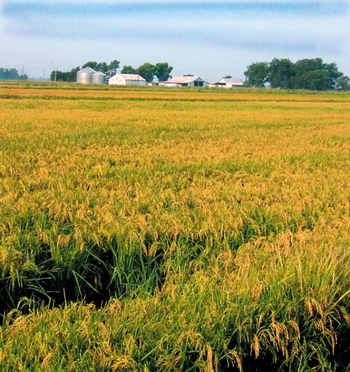
Programs in the new farm bill "aren't going to be enough to keep you in business if you have a really disastrous year,” says Keith Coble, Mississippi State University Exension professor of agricultural economics, who spoke at the annual meeting of the Mississippi Land Bank. “They are meant to supplement other parts of your risk management program.”

As you contemplate all the acronyms — ARC, PLC, STAX, etc. —and complexities of the new crop insurance-based farm legislation, Keith Coble has some cautionary advice for you: “Don’t get terribly wrapped up in thinking that these programs are going to keep you in business.
“They aren’t enough to keep you in business if you have a really disastrous year,” he said at the annual meeting of the Mississippi Land Bank. “They are meant to supplement other parts of your risk management program.”
And he says, “Everyone — producers and lenders — is going to have to become more sophisticated about managing risk.”

“The ink is not dry on this bill, and already assaults are under way in Congress," says Keith Coble, who helped draft the legislation.
Coble, who is Giles Distinguished Professor of Agricultural Economics at Mississippi State University and one of the nation’s leading experts on farm programs, spent a year in Washington as chief economist for the minority staff of the Senate Agriculture, Nutrition, and Forestry Committee, helping to craft the farm bill.
“Given the costs of production, projected prices, etc.,” he says, “I wouldn’t be distorting my planting decisions based on what I think ARC (Agricultural Risk Coverage) and PLC (Price Loss Coverage) are going to do for me.”
There is variation in terms of payout across commodities, he notes, “and you need to keep in mind that USDA projections are not very positive right now. One of the problems is that we start our projections with USDA’s price projections, and these produce very different results than if we start with futures market projections.
“You don’t want to make participation decisions until you have as much information as possible. There are some terribly complicated choices, some of which you have to make this year — and then you’re going to have to live with those choices for the next five years.”
Producers are going to face “a one-time big choice between participating in the ARC program or the PLC program, he says.
For example, the farm operator will get to make the choice of which program will be followed. “Landowners may have input in this decision, but the law says the operator gets to choose the program. However, the landowner gets to choose the updating of base and yields.
“From what we’re hearing from USDA, this will probably take place sometime this fall. You will be allowed to do this by farm serial number and commodity — and that’s an important distinction. I think producers are likely to choose to go into different programs for different commodities.”
Particularly for corn and soybeans, “The ARC program is going to look much more attractive in 2014 than it will look in 2016 or 2017. Don’t make the mistake of thinking that how it looks today is how it will look over time."
Coverage for cotton
Cotton growers, Coble says, will need to pay attention to SCO (Supplemental Coverage Option) and STAX (Stacked Income Protection Program), the latter for cotton only.
“These are very similar in terms of mechanics, the way they’ll be calculated, etc. Ultimately, they are area revenue products that are like ARC, in that they’re shallow loss programs. They’re not going to protect you from a disastrous year; they are meant to primarily supplement an underlying crop insurance policy.”

BOBBY SPINKS, from left, Clarksdale, Miss., and Lee Tucker, Corinth, Miss.; both with the Mississippi Land Bank, and Tully Boyer, Cleveland, Miss., a MLB retiree, were among those attending the organization’s annual meeting.
Because of the Brazil cotton case and other factors, Coble says, “The cotton industry took a really dramatic step away from traditional programs toward an insurance-based program. It was rather fascinating that with all the squabbling over a lot of provisions of the commodity titles, we kept expecting an attack on the STAX program — and for the most part, it never happened.”
STAX is “going to look a lot like the shallow loss revenue programs,” he notes, “and will protect a range of coverage from 90 percent down to 70 percent of expected revenue. So if you have a catastrophic event, this program will start paying at 90 percent of the county revenue and stop paying at 70 percent — and you’re exposed for everything else.
“Please understand: you can’t buy this program and expect to be covered for deep loss, because you won’t be. You don’t have to buy underlying crop insurance to buy STAX, but you can if you wish to. You can’t buy STAX and SCO on the same acre — you have to choose between the two programs. Our analysis suggests you’re probably going to want STAX rather than SCO on cotton.”
PLEASE SEE ALSO: Base reallocation mechanism drawing farmer questions
A major change in this farm bill, Coble notes, is that “you can have two crop insurance policies on the same acre of a crop. If you choose to participate in the SCO program on soybeans, for example, you can have your underlying crop insurance policy, and if you want to, you can have SCO coverage layered on top of that.”
And Coble says, “Conservation compliance has been attached to crop insurance — something that had not existed in the past.”
Among things to be aware of, he says: “You need to ask about enterprise units. If you haven’t investigated this in the past, you need to do so. Provisions of this bill allow enterprises to break out between dryland and irrigated; this is likely to be attractive to producers with mixed dryland and irrigated operations. You also can separate these and have different coverages. For example, you can choose to buy 85 percent coverage on your dryland production, and 65 percent on irrigated. This gives you added flexibility.”
Ask about alternatives
Crop insurance subsidy percentage varies by coverage level, Coble points out, “and that is important. These are things you need to keep in mind when you talk to a crop insurance agent. Ask about the various alternatives — and remember that this legislation breaks out enterprise units more finely than in the past.”
Despite its complicated language, some aspects of the new legislation, he says, “will be fairly easy calls for producers to make.

Despite its complicated language, some aspects of the new legislation “will be fairly easy calls for producers to make," says Keith Coble.
“Converting cotton base to generic base is pretty much a no-brainer. Updating yields — most people have base yields that are out of date, and this is something you’re likely to want to do; And I think STAX will be preferred over SCO for almost any cotton in this state.
“On the other hand, I don’t see farm level ARC being very attractive to producers in Mississippi, unless you grow just one commodity.”
It is important to remember, Coble says, that “area-triggered programs may not trigger when you have loss. What really determines whether they work for you is whether your losses going to occur when the county has a bad year?
“It’s not really about whether you’re higher or lower on average than the county; it’s about whether when you have a bad year, does your county also have a bad year? If you are basically all irrigated and your county is mostly non-irrigated, this can be a problem.
SEE ALSO: Significantly different farm bill will need educational effort
“Remember: Title 1 programs are on base acres. For example, you may be getting a payment for soybean base, but you may be growing corn or some other commodity on that base.
“Also lenders need to keep in mind that while, in the past, you may have plugged in a farm program payment to a loan analysis and said, ‘OK, this will cash flow this farm,’ you can’t do that any more, because that direct payment is not there. Instead, you’ll be looking at the expectation of payments from ARC, PLC, SCO, STAX, etc.”
Expect fewer subsidies in future
For the longer-term perspective, Coble says, “Farm bills are getting much harder to pass — and we’re in a much different environment than in the past. If you’re a lender talking to a producer about long-term projections, expect fewer subsidies in the future.
“The ink is not dry on this bill, and already assaults are under way. Crop insurance, which is the foundation of this legislation, is being attacked by budget cutters and is the focus for opposition by environmental groups. I think we can expect that this will continue, and that crop insurance will be under the magnifying glass for the next five years.”
To both producers and lenders, Coble says, “Expect to have to manage your risk more on your own, and expect it to be more complex. As an example, think about having insured soybeans on rice base enrolled in the PLC program, insured corn enrolled in a county ARC program planted on generic base — what’s your risk position?
“What forward pricing strategy do you take when you’ve got these kind of programs? We can create scenarios where you could double down your risk by having layers of programs overlapping each other. It’s going to be tough to figure these things.

“We’re seeing novel new ways of managing risk that I think will require producers and lenders to become more sophisticated in their understanding of risk," Keith Coble says of the new farm bill.
“Everyone is going to have to be more sophisticated about managing risk. One of the things I worry about: Is the crop insurance agent going to give the producer one message, while lenders give another, and input suppliers and market suppliers tell him something different — how do you sort through all that information?
“Some of these risks can be managed, but I’m not sure you can really manage the risk of such things as what’s going to happen to the Renewable Fuels Standard over the next five years. That’s a big risk if you’re wanting to grow corn. It’s policy risk —and we don’t have tools to manage policy risk.
READ MORE: With farm bill done, major issues remain for agriculture
“We’re seeing novel new ways of managing risk that I think will require producers and lenders to become more sophisticated in their understanding of risk. There are things you simply can’t quantify, because they’ve become so complex — and this is, unfortunately, the complicated future you face.”
Mississippi State University Extension and research stations have resources that can be of use in making these decision, Coble notes.
“We will be making more information available as more becomes known about this legislation and how it will be implemented. This will be available on our websites and blogs.”
Farm bill support tools and calculators can be found here: http://bit.ly/P3x0FR
About the Author(s)
You May Also Like



